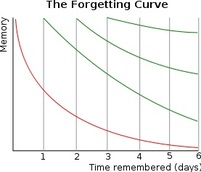Posted by:
Spaced Repetition: A Simple Flashcard Method for Improving Long-Term Retention
 When you learn something, you can easily remember it for a little while. But as time goes on, it becomes harder and harder to remember it. Eventually, you can no longer remember it, even with hints. This is called the “forgetting curve.”
When you learn something, you can easily remember it for a little while. But as time goes on, it becomes harder and harder to remember it. Eventually, you can no longer remember it, even with hints. This is called the “forgetting curve.”
In “spaced repetition,” the main idea is to review material at key intervals. These key intervals will maximize long-term retention. There are different formulas to calculate how long this “key interval” should be. Different computer programs use these different formulas in their software. SuperMemo and Mnemosyne are two of the better-known programs of this type.

We are going to look at a flashcard system that uses spaced repetition. This system will help you to review material according to a schedule. The schedule will maximize long-term retention. Because this system uses spaced repetition, you will receive many of the same benefits as using a flashcard program like SuperMemo or Mnemosyne.
This system will work for anything you want to learn long-term: spelling, vocabulary words, medical terms, facts for chemistry or biology – anything!
Write a List
- Write a list of whatever you want to learn.
- Make flashcards for each item on your list. (There are advantages to having physical flash cards. For one thing, you can carry them with you. For another thing, you can work on them whenever you have some spare time.)
- Use paper that’s a little bit heavier. Then they won’t tear so easily. (In the US, we often use “index cards” when we make flash cards.)
- On each card, write a quiz question – usually, a word or fact from your list.
- On the back side of the card, write the answer to your quiz question – what the word is in your native language, or how it is spelled/pronounced, and so on.
After you’ve written all the items from your list on the flash cards, you will have a stack of flash cards to work on. Flip them over so you see the quiz question.
The Review System
Start: Pick up the first card.
Step 1: Read the quiz question.
Step 2: Answer the quiz question.
- If it’s a vocabulary word, say what the meaning is.
- If you’re quizzing yourself on foreign language vocabulary:
(i) Say the word out loud in the target language.
(ii) Say the word out loud in your mother tongue.
Step 3: Check yourself.
- If you answered the quiz question correctly, put it in the “good” pile.
- If you did not answer the quiz question correctly, or if you had to think longer than a few seconds to remember the answer, put it in the “bad” pile.
Step 4: Pick up the next card, and go back to Step 1.
Read all the flash cards in your stack until you get to the last card. When you have finished going through the stack, you’ll have two piles: the “good” pile and the “bad” pile.
- You can put the good pile aside and leave them for tomorrow.
- Take the bad pile and go through them again, like the first time.
- Quiz questions that are answered correctly go in the good pile.
- Quiz questions that are not answered correctly go in the bad pile.
Keep on repeating with the bad pile until all the cards have moved from the bad pile to the good pile. You’re done for the day!
Repeat this process every day. As you improve, you should notice that the bad pile gets smaller day by day, even on the first time you go through the pile.
If a card is in the good pile for several days in a row (for example, every day for a week), you can move it to a “once a week” pile. You know these cards fairly well now, so you don’t have to review them every day. Once a week will be often enough. If you forget the correct quiz answer to one of your “once a week” cards, move it to the bad pile for your daily review. Eventually, all your cards will move to this “once a week” pile.
In the same way, you can create a “once a month” pile. These are cards that are in the good “once a week” pile for several weeks. This pile will have cards that need review only once a month. If you forget the correct quiz answer to a card in the “once a month” pile, move it back to the “once a week” pile. By the time a card moves to the “once a month” pile, it has gone into your long-term memory. This means that you know it fairly well, and you don’t have to review it so often. You’ll probably remember it for the rest of your life!
